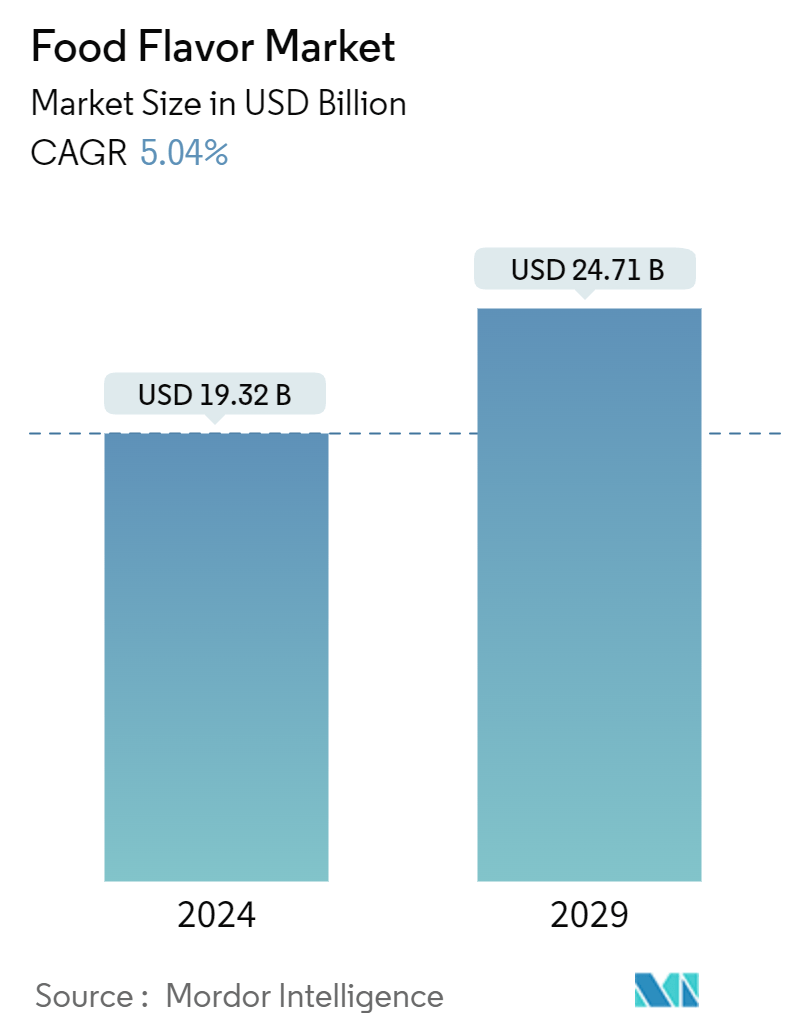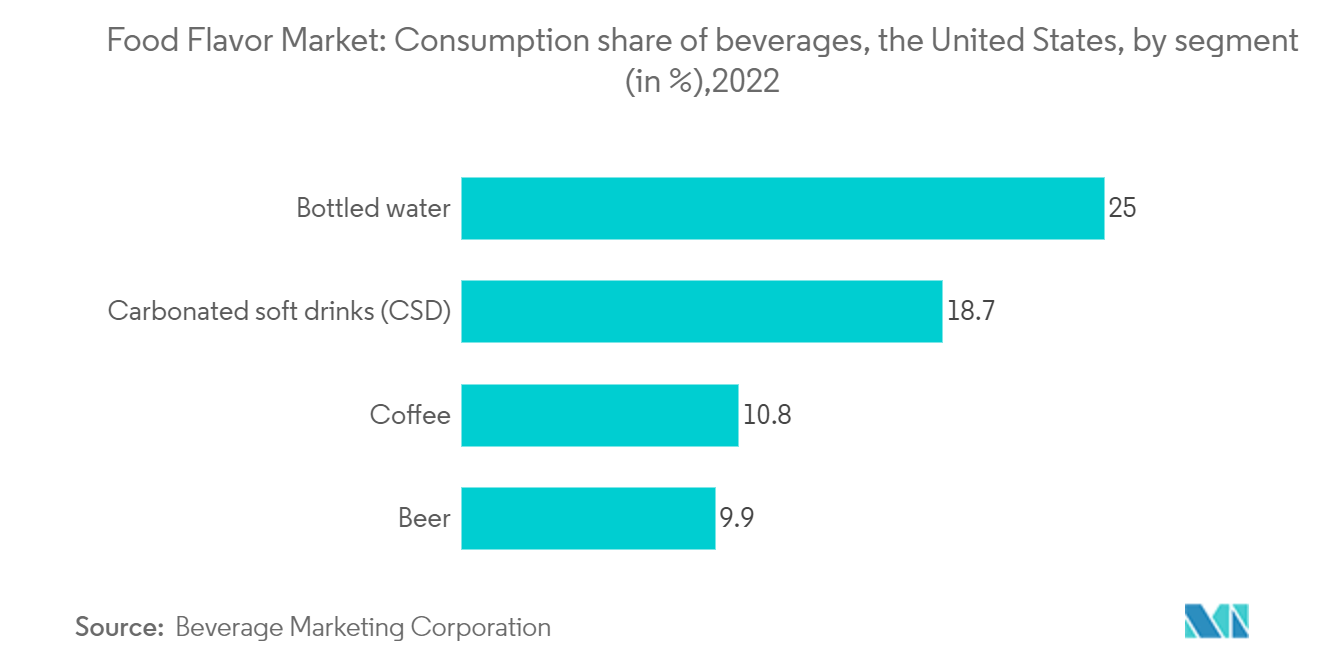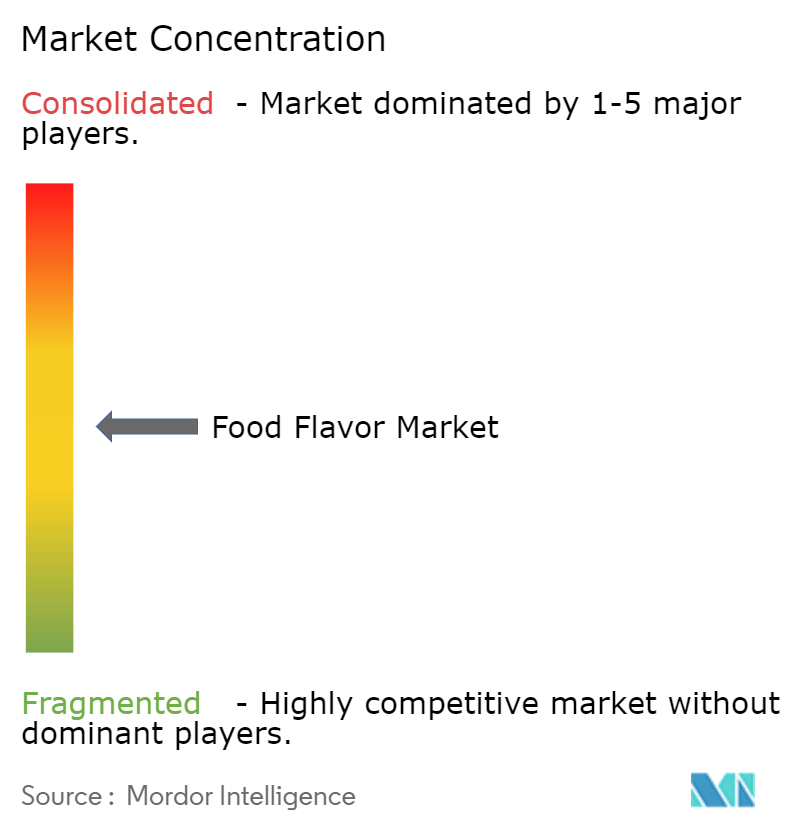Food Flavors Market Size

| Study Period | 2019 - 2029 |
| Market Size (2024) | USD 19.32 Billion |
| Market Size (2029) | USD 24.71 Billion |
| CAGR (2024 - 2029) | 5.04 % |
| Fastest Growing Market | Asia |
| Largest Market | Asia |
Major Players.webp)
*Disclaimer: Major Players sorted in no particular order |
Food Flavors Market Analysis
The Food Flavor Market size is estimated at USD 19.32 billion in 2024, and is expected to reach USD 24.71 billion by 2029, at a CAGR of 5.04% during the forecast period (2024-2029).
Various factors, including shifting consumer preferences, evolving industry trends, and global influences, are driving the demand for food flavors worldwide. As consumers increasingly seek out nutritionally enriched and all-natural products, the market is witnessing a surge in demand for premium, natural additives and flavors. This trend is further bolstered by the growing popularity of botanical flavors, especially for their perceived health benefits among consumers. Consumers prefer products that go beyond basic nutrition, focusing on elements like probiotics, ginger, and trendy adaptogens like moringa, turmeric, and coffee bean extract. These ingredients are aimed at bolstering the immune and digestive systems and providing an energy boost in functional foods and beverages. Furthermore, consumers are turning to herbal and botanical extracts, like lavender, roses, chamomile, cinnamon, and cardamom, to meet goals related to mood enhancement, beauty, and antioxidant intake. In addition, advances in food technology have enabled the creation of more complex and nuanced flavors. Techniques such as fermentation, molecular gastronomy, and flavor encapsulation allow for developing new and innovative taste profiles.
Food Flavors Market Trends
Rising Demand for Beverages Drive Application of Flavors
Food flavors find applications in a variety of beverages, including alcoholic drinks, carbonated beverages, coffee, tea, energy drinks, flavored water, juice-based drinks, and sports drinks. consumers nowadays seek more from their beverages than mere thirst quenching. As a result, drinks like soft drinks and smoothies are evolving to provide unique experiences and flavor bursts tailored to individual preferences. Shifting dietary preferences and a growing young demographic are driving the demand for carbonated beverages. Furthermore, the rising trend of processed products is amplifying carbonated drink consumption. There is a surging demand for natural food flavors in beverages, largely driven by consumers' increasing preference for clean-label products that emphasize naturally sourced ingredients. Notably, in January 2024, Molson Coors Beverage Company introduced a new flavor, Limeade, boasting 5% real fruit juice, freshly squeezed and concentrated.

Asia Pacific Holds Major Share in Food Flavor Market
With the rise in urbanization and increase in working population, the Chinese market is witnessing a rising demand for packaged food, which is thereby increasing the need for food processing solutions. Therefore, to preserve the freshness, safety, taste, appearance, and texture of products, the demand for food flavors is rising in China.
Japan boasts a renowned food culture, celebrated for its meticulousness, premium ingredients, and a wide array of flavors. The demand for flavor ingredients in Japan is shaped by a myriad of factors, spanning cultural inclinations, culinary legacies, health consciousness, and evolving consumer preferences. Japan offers a variety range of functional ingredients controlled by its Food for Specified Health Use (FOSHU) regulatory requirements approved by the Ministry of Health and Welfare. The country is industrially rich. Hence, it provides a good opportunity for manufacturers to offer their products to the freshly blooming local industries and establish a strong consumer base in the local market.
Australian food and beverage manufacturers are increasingly turning to food flavors, driven by several key factors. A significant driver is multicultural population, which boasts a wide array of taste preferences. This rich diversity has cultivated a growing appetite for an extensive range of flavors, drawing from global influences. As ethnic cuisines gain traction, they mold mainstream food preferences, compelling manufacturers to expand their flavor offerings.

Food Flavors Industry Overview
The global food flavor market is competitive. Key players include Givaudan, Cargill Inc., International Flavors and Fragrances Inc., DSM-Firmenich AG, and Symrise AG. These major companies are adopting strategies like introducing clean labels, launching organic flavor ranges, and forming partnerships or acquiring local players to penetrate untapped markets. By launching new products, these giant manufacturers not only boost sales but also capture consumer attention and enhance brand value. In addition to the major players, several other companies are focusing on online distribution channels to brand their products, expand geographic reach, and grow their customer base.
Food Flavors Market Leaders
-
Symrise AG
-
Cargill Inc.
-
Givaudan SA
-
DSM-Firmenich AG
-
International Flavors and Fragrances Inc.
*Disclaimer: Major Players sorted in no particular order

Food Flavors Market News
- April 2024: The Kerry Group introduced Tastesense Salt, a solution that imparts a rich savory flavor without the addition of sodium. This innovation preserves essential flavor properties, replicating the salty impact, body, and lingering taste.
- March 2024: BASF Aroma Ingredients expanded its Isobionics portfolio with new natural flavors. Isobionics Natural beta-Caryophyllene 80 is the latest addition to the Isobionics flavor portfolio.
- February 2024: The Kerry Group released its 2024 global taste charts. These charts track flavor adoption and evolution around the world and provide an in-depth analysis of the ingredients and trends that may shape innovation in the food and beverage sector over the year ahead.
Food Flavors Market Report - Table of Contents
1. INTRODUCTION
- 1.1 Study Assumptions and Market Definition
- 1.2 Scope of the Study
2. RESEARCH METHODOLOGY
3. EXECUTIVE SUMMARY
4. MARKET DYNAMICS
-
4.1 Market Drivers
- 4.1.1 Increasing Preference for Ready Meals
- 4.1.2 Launch of Natural Variants
-
4.2 Market Restraints
- 4.2.1 Changing Regulatory Landscape
-
4.3 Porter's Five Forces Analysis
- 4.3.1 Bargaining Power of Buyers/Consumers
- 4.3.2 Bargaining Power of Suppliers
- 4.3.3 Threat of New Entrants
- 4.3.4 Threat of Substitute Products
- 4.3.5 Intensity of Competitive Rivalry
5. MARKET SEGMENTATION
-
5.1 Type
- 5.1.1 Natural Flavor
- 5.1.2 Synthetic Flavor
- 5.1.3 Nature Identical Flavoring
-
5.2 Application
- 5.2.1 Dairy
- 5.2.2 Bakery
- 5.2.3 Confectionery
- 5.2.4 Savory Snack
- 5.2.5 Beverage
- 5.2.6 Meat
- 5.2.7 Other Applications
-
5.3 Geography
- 5.3.1 North America
- 5.3.1.1 United States
- 5.3.1.2 Canada
- 5.3.1.3 Mexico
- 5.3.1.4 Rest of North America
- 5.3.2 Europe
- 5.3.2.1 Spain
- 5.3.2.2 United Kingdom
- 5.3.2.3 Germany
- 5.3.2.4 France
- 5.3.2.5 Italy
- 5.3.2.6 Russia
- 5.3.2.7 Rest of Europe
- 5.3.3 Asia-Pacific
- 5.3.3.1 China
- 5.3.3.2 Japan
- 5.3.3.3 India
- 5.3.3.4 Australia
- 5.3.3.5 Rest of Asia-Pacific
- 5.3.4 South America
- 5.3.4.1 Brazil
- 5.3.4.2 Argentina
- 5.3.4.3 Rest of South America
- 5.3.5 Middle-East and Africa
- 5.3.5.1 South Africa
- 5.3.5.2 Saudi Arabia
- 5.3.5.3 Rest of Middle-East and Africa
6. COMPETITIVE LANDSCAPE
- 6.1 Market Share Analysis
- 6.2 Most Adopted Strategies
-
6.3 Company Profiles
- 6.3.1 Koninklijke DSM NV
- 6.3.2 Kerry Group PLC
- 6.3.3 BASF SE
- 6.3.4 Archer Daniels Midland (ADM)
- 6.3.5 Givaudan SA
- 6.3.6 Sensient Technologies
- 6.3.7 Symrise AG
- 6.3.8 Cargill Inc.
- 6.3.9 International Flavors & Fragrances Inc.
- 6.3.10 Takasago International Corporation
- *List Not Exhaustive
7. MARKET OPPORTUNITIES AND FUTURE TRENDS
** Subject To AvailablityFood Flavors Industry Segmentation
Food flavors are ingredients used to improve the flavor of food and beverage products.
The global food flavor market is segmented by type, application, and geography. By type, the market is segmented into natural flavor, synthetic flavor, and nature-identical flavoring. By application, the market has been segmented into dairy, meat, bakery, confectionery, savory snack, beverage, and other applications. By geography, the market is segmented into North America, Europe, Asia-Pacific, South America, the Middle East, and Africa.
The report offers market size and forecasts for the confectionery market in value (USD) for all the above segments.
| Type | Natural Flavor | |
| Synthetic Flavor | ||
| Nature Identical Flavoring | ||
| Application | Dairy | |
| Bakery | ||
| Confectionery | ||
| Savory Snack | ||
| Beverage | ||
| Meat | ||
| Other Applications | ||
| Geography | North America | United States |
| Canada | ||
| Mexico | ||
| Rest of North America | ||
| Geography | Europe | Spain |
| United Kingdom | ||
| Germany | ||
| France | ||
| Italy | ||
| Russia | ||
| Rest of Europe | ||
| Geography | Asia-Pacific | China |
| Japan | ||
| India | ||
| Australia | ||
| Rest of Asia-Pacific | ||
| Geography | South America | Brazil |
| Argentina | ||
| Rest of South America | ||
| Geography | Middle-East and Africa | South Africa |
| Saudi Arabia | ||
| Rest of Middle-East and Africa |
Food Flavors Market Research FAQs
How big is the Food Flavor Market?
The Food Flavor Market size is expected to reach USD 19.32 billion in 2024 and grow at a CAGR of 5.04% to reach USD 24.71 billion by 2029.
What is the current Food Flavor Market size?
In 2024, the Food Flavor Market size is expected to reach USD 19.32 billion.
Who are the key players in Food Flavor Market?
Symrise AG, Cargill Inc., Givaudan SA, DSM-Firmenich AG and International Flavors and Fragrances Inc. are the major companies operating in the Food Flavor Market.
Which is the fastest growing region in Food Flavor Market?
Asia is estimated to grow at the highest CAGR over the forecast period (2024-2029).
Which region has the biggest share in Food Flavor Market?
In 2024, the Asia accounts for the largest market share in Food Flavor Market.
What years does this Food Flavor Market cover, and what was the market size in 2023?
In 2023, the Food Flavor Market size was estimated at USD 18.35 billion. The report covers the Food Flavor Market historical market size for years: 2019, 2020, 2021, 2022 and 2023. The report also forecasts the Food Flavor Market size for years: 2024, 2025, 2026, 2027, 2028 and 2029.
Food Flavors Industry Report
The food flavor market is segmented by type, including natural flavor, synthetic flavor, and nature-identical flavoring. Applications span across dairy, meat, bakery, confectionery, savory snacks, beverages, and other applications. Geographically, the market is divided into North America, Europe, Asia-Pacific, South America, and the Middle East and Africa. The market size and forecasts for the food flavor market are provided in terms of value for all the above segments.
Industry analysis reveals that the food flavor market is poised for significant growth. The market size and global market trends indicate a robust industry outlook. Market leaders in the food flavor industry are continuously innovating to capture a larger market share. The market analysis and market forecast suggest steady market growth driven by increasing demand across various applications.
Industry reports and market research provide detailed insights into the market segmentation and market value. These reports offer a comprehensive market overview and market review, highlighting the industry trends and market predictions. The industry statistics and industry information are crucial for understanding the market dynamics and making informed decisions.
The growth rate of the food flavor market underscores the importance of staying updated with industry research and industry sales data. Market data and market forecast are essential tools for predicting future market conditions. The industry size and industry outlook are critical for stakeholders to strategize their market approach effectively.
For a detailed understanding of the food flavor market, one can refer to the report example and download the report PDF. This comprehensive analysis is indispensable for research companies and industry professionals looking to gain a competitive edge in the market.



